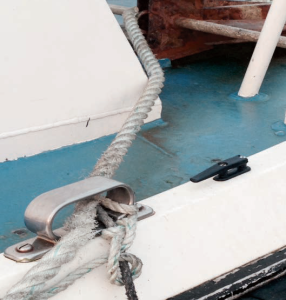The Charity
Aviation
Maritime
Safety concerns of domestic ferry

Initial Report
Report Text:
The reporter was a regular passenger travelling from “A” to “B” which crosses from the main – land to a small Island. Prior to boarding one day, it was noted that the relief ferry was being secured to the slipway on the island using only a frayed bow line as a spring, the vessel being left powering against the spring while passengers dis embarked and embarked. The reporter’s concern is that the rope might break, or the vessel might pull a ring out of the pier as considerable power is used to hold the vessel against the slipway, especially if the tide is ebbing hard, or a strong offshore breeze is present.
The reporter’s concerns are compounded by the fact that the skipper does not stay at the helm during loading and unloading. Of lesser concern is that no safety announcements are taking place, which is common on this route.
Lessons Learned: The crew could usefully be sent on a safety awareness course and then adequately supervised to ensure compliance with safety regulations.
CHIRP contacted the port authority. They are also the charterer of the ferry and they advised, the “Ferry” has been used as a relief vessel for the “Main Ferry” since 2007 and admitted the relief ferry is not completely adequate for the loading and unloading of passengers. The ferry operator’s safety meeting considered whether 3 crew are required to work the vessel safely so that the skipper could remain in the helmsman position at all times while loading and unloading of passengers. It was decided only the skipper and 1 crewman was sufficient because the crewman would come out of the wheel house door on the port side and walk round the bow before securing the boat. That means the skipper has a visual on the crewman at all times. Also there was a stern rope secured on the starboard aft bollard to secure the vessel at point. 2 ropes on the vessel, 1 spring and 1 aft secure the vessel. The starboard engine is kept in gear, ticking over to ensure there is no gap between the vessel and the slip, this is a must as it is the only way to keep the boat tight against the pier. The bow rope is used as a spring, which showed some light fraying on the outer part of the rope; the rope was checked regularly and passed as fit for use. The pier rings were, as a result of a safety meeting, all changed to bigger and stronger versions. The safety announcements for passengers is claimed to be done on a regular basis.
CHIRP Comment
Whilst the management may claim a good safety record, there is an apparent lack of appreciation of the risk to the traveling public as identified by this report. The port authority was advised to read and understand the implications of the MAIB report 12/2009 on the Hurlingham. The ferry was secured to the pier using one mooring line at the bow, and the skipper had left the wheelhouse unattended with the engine in gear while he attended to the bar account and tidied up after the party. The stern of the boat drifted away from the pier, and the mate moved from his position on the pier, supervising the passengers disembarking, to manoeuvre the boat back alongside and attach two more mooring lines. No gangway was used and passengers were allowed to continue disembarking unsupervised while the boat was put back into position. Shortly after the stern was brought back into the pier, a gap opened up between the front of the boat and pier at the point where passengers were disembarking. One passenger stepped forward and fell into the gap. Despite an extensive search, he could not be found and his body was recovered further downriver The chief mate received a custodial sentence of 15 months.
In the event the Maritime and Coastguard Agency (MCA) was to investigate a similar incident, they will take a very serious view on any breaches of duty and the absence of the ordinary good practice of seamen.
The port authority‘s attention was also drawn to the MAIB report 3/2005, which describes how a waiting passenger died after being hit by a mooring bollard that detached from the deck of the fast catamaran ‘Star Clipper’ when the vessel was being held alongside a tidal jetty using a single spring and ahead power.
The introduction of a relief ferry to cover that used in the main contract must not result in a reduction in the level of safety for the passengers and crew. The practice used by the master of the ferry indicates there may be an insufficient number of crewmembers for the operations. Although there will be a minimum manning level for the vessel, a risk assessment of the operations will confirm the appropriate manning levels and that may exceed this number.








